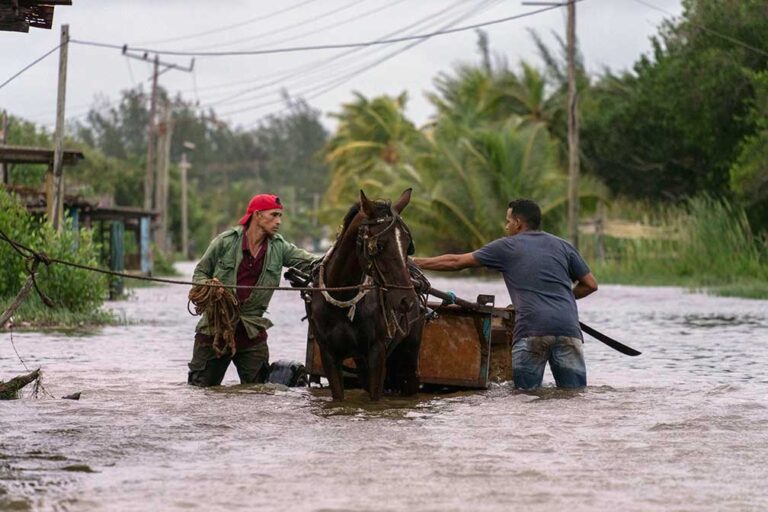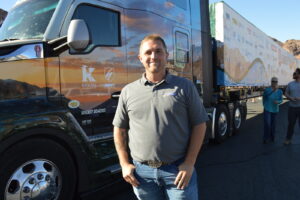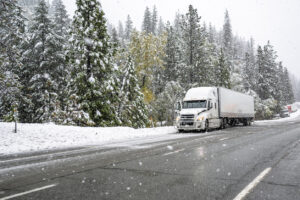Updated Sept. 26, 2024, at 1 p.m. Pacific time
CRAWFORDVILLE, Fla. — Tropical storm force winds began battering Florida on Thursday, Sept. 26, as Hurricane Helene prepared to make landfall, with forecasters warning that the enormous storm could create a “nightmare” surge along the coast and churn up damaging winds hundreds of miles inland across much of the southeastern U.S.
Helene was upgraded to a major Category 3 storm Thursday afternoon ahead of its expected evening landfall on Florida’s northwestern coast. Hurricane and flash flood warnings extend far beyond the coast up into south-central Georgia.
It was starting to be felt Thursday afternoon, with water lapping over a road on the northern tip of Siesta Key near Sarasota and covering some intersections in St. Pete Beach along Florida’s Gulf Coast. The winds have left around 100,000 homes and businesses without power already in the state. And rain has started battering places like Asheville, North Carolina, where a 7-inch deluge has raised flooding concerns.
With forecasters also warning of tornadoes and mudslides, the governors of Florida, Georgia, the Carolinas and Virginia have all declared emergencies, as did President Joe Biden for several of the states. He is sending the head of the Federal Emergency Management Agency to Florida on Friday to view the damage.
Florida Gov. Ron DeSantis said Thursday morning that models suggest Helene will make landfall further east, lessening the chances for a direct hit on the capital city of Tallahassee, whose metro area has a population of around 395,000.
The shift has the storm aimed squarely at the sparsely-populated Big Bend area, home to fishing villages and vacation hideaways where Florida’s Panhandle and peninsula meet. Shuttered gas stations dotted the two-lane highway, their windows boarded up with plywood.
Philip Tooke, a commercial fisherman who took over the business his father founded near the region’s Apalachee Bay, plans to ride out this storm like he did during Hurricane Michael and the others — on his boat. “This is what pays my bills,” Tooke said of his boats. “If I lose that, I don’t have anything.”
Many, though, were heeding the mandatory evacuation orders that stretched from the Panhandle south along the Gulf Coast in low-lying areas around Tallahassee, Gainesville, Cedar Key, Lake City, Tampa and Sarasota.
Among them was Sharonda Davis, one of several gathered at a Tallahassee shelter worried their mobile homes wouldn’t withstand the winds. She said the hurricane’s size is “scarier than anything because it’s the aftermath that we’re going to have to face.”
Federal authorities were staging search-and-rescue teams as the National Weather Service office in Tallahassee forecast storm surges of up to 20 feet and warned they could be particularly “catastrophic and unsurvivable” in Apalachee Bay. It added that high winds and heavy rains also posed risks.
“Please, please, please take any evacuation orders seriously!” the office said, describing the surge scenario as “a nightmare.”
This stretch of Florida known as the Forgotten Coast has been largely spared by the widespread condo development and commercialization that dominates so many of Florida’s beach communities. The region is loved for its natural wonders — the vast stretches of salt marshes, tidal pools and barrier islands; the dwarf cypress trees of Tate’s Hell State Forest; and Wakulla Springs, considered one of the world’s largest and deepest freshwater springs.
Anthony Godwin, 20, found one gas station outside Crawfordville where the tanks were still running Thursday morning to fill up before heading west toward his sister’s house in Pensacola.
“It’s a part of life. You live down here, you run the risk of losing everything to a bad storm,” said Godwin, who lives about a half-mile from the water in the coastal town of Panacea.
Along Florida’s Gulf Coast, school districts and multiple universities have canceled classes. Airports in Tampa, Tallahassee and Clearwater were closed Thursday, while cancellations were widespread elsewhere in the state and beyond.
Helene was about 195 miles southwest of Tampa on Thursday afternoon and moving north-northeast at 16 mph with top sustained winds of at least 111 mph.
While Helene will likely weaken as it moves inland, damaging winds were expected to extend to the southern Appalachian Mountains, where landslides were possible, forecasters said. The center posted lesser tropical storm warnings as far north as North Carolina, and warned that much of the region could experience prolonged power outages and flooding. Tennessee was among the states expected to get drenched.
Helene had swamped parts of Mexico’s Yucatan Peninsula on Wednesday, flooding streets and toppling trees as it passed offshore and brushed the resort city of Cancun.
The storm formed Tuesday in the Caribbean Sea. In western Cuba, Helene knocked out power to more than 200,000 homes and businesses as it brushed past the island.
Helene is forecast to be one of the largest storms in breadth in years to hit the region, said Colorado State University hurricane researcher Phil Klotzbach. He said since 1988, only three Gulf hurricanes were bigger than Helene’s predicted size: 2017’s Irma, 2005’s Wilma and 1995’s Opal.
Areas 100 miles north of the Georgia-Florida line can expect hurricane conditions. More than half of Georgia’s public school districts and several universities canceled classes. The state has opened its parks to evacuees, and their pets, including horses
For Atlanta, Helene could be the worst strike on a major Southern inland city in 35 years, said University of Georgia meteorology professor Marshall Shepherd.
More than 200 miles to the south, some businesses in the inland city of Valdosta, Georgia, closed because of the hurricane warning, including the local Walmart.
“We know the Lord’s in control,” said 67-year-old Margaret Freenman, when she found pallets stacked high blocking the store’s entrances after showing up to buy snacks with her two grandchildren. “He’s got the last say.”
Helene is the eighth named storm of the Atlantic hurricane season, which began June 1. The National Oceanic and Atmospheric Administration has predicted an above-average Atlantic hurricane season this year because of record-warm ocean temperatures.
In further storm activity, Tropical Storm Isaac formed Wednesday in the Atlantic and was expected to strengthen as it moves eastward across the open ocean, possibly becoming a hurricane by the end of the week, forecasters said. Officials said its swells and winds could affect parts of Bermuda and eventually the Azores by the weekend.
In the Pacific, former Hurricane John reformed Wednesday as a tropical storm and strengthened Thursday morning back into a hurricane as it threatened areas of Mexico’s western coast with flash flooding and mudslides. Mexico President Andrés Manuel López Obrador raised John’s death toll to five Thursday as the communities along the country’s Pacific coast prepared for the storm to make a second landfall.
Original story posted Sept. 26, 2024, at 7:44 a.m. Pacific time
TALLAHASSEE, Fla. — Fast-moving Hurricane Helene was advancing Thursday, Sept. 26, across the Gulf of Mexico toward Florida, threatening an “unsurvivable” storm surge in northwestern parts of the state as well as damaging winds, rains and flash floods hundreds of miles inland across much of the southeastern U.S., forecasters said.
Helene was upgraded Thursday morning to a Category 2 storm and is expected to be a major hurricane — meaning a Category 3 or higher — when it makes landfall on Florida’s northwestern coast Thursday evening. As of early Thursday, hurricane warnings and flash flood warnings extended far beyond the coast up into south-central Georgia. The governors of Florida, Georgia, the Carolinas and Virginia have all declared emergencies in their states.
Rain was beginning to blow in the predawn darkness Thursday along coastal U.S. Highway 98, which winds through countless fishing villages and vacation hideaways along Florida’s Big Bend. Shuttered gas stations dotted the two-lane highway, their windows boarded up with plywood to protect from the storm. The road was largely empty at first light on Thursday, with what drivers there were mostly heading northeast, towards higher ground.
The storm was expected to make landfall in the Big Bend region, where Florida’s panhandle and peninsula meet, according to Jack Beven, senior hurricane specialist at the National Hurricane Center in Miami.
“Regardless of how strong it is, it is a very large storm, Beven said. “It’s going to have impacts that cover a large area.”
The National Weather Service office in Tallahassee forecast storm surges of up to 20 feet and warned they could be particularly “catastrophic and unsurvivable” in Florida’s Apalachee Bay. It added that high winds and heavy rains also posed risks.
“This forecast, if realized, is a nightmare surge scenario for Apalachee Bay,” the office said. “Please, please, please take any evacuation orders seriously!”
This stretch of Florida known as the Forgotten Coast has been largely spared by the widespread condo development and commercialization that dominates so many of Florida’s beach communities. The sparsely populated region is loved for its natural wonders — the vast stretches of salt marshes, tidal pools and barrier islands; the dwarf cypress trees of Tate’s Hell State Forest; and Wakulla Springs, considered one of the world’s largest and deepest freshwater springs.
In Crawfordville, farther inland and about 25 miles northwest of Apalachee Bay, Christine Nazworth stocked up on bottled water, baked goods and premade meals at a Walmart. She said her family would be sheltering in place, despite Wakulla County issuing a mandatory evacuation order.
“I’m prayed up,” she said. “Lord have mercy on us. And everybody else that might be in its path.”
Along Florida’s Gulf Coast, school districts and multiple universities have cancelled classes.
Helene was about 320 miles southwest of Tampa on Thursday morning and moving north-northeast at 12 mph with top sustained winds of 100 mph. Forecasters said it should become a Category 3 or higher hurricane, meaning winds would top 110 mph.
While Helene will likely weaken as it moves inland, its “fast forward speed will allow strong, damaging winds, especially in gusts, to penetrate well inland across the southeastern United States,” including in the southern Appalachian Mountains, the hurricane center said. The center posted lesser tropical storm warnings as far north as North Carolina and warned that much of the region could experience prolonged power outages, toppled trees and dangerous flooding.
Helene had swamped parts of Mexico’s Yucatan Peninsula on Wednesday, flooding streets and toppling trees as it passed offshore and brushed the resort city of Cancun.
The storm formed Tuesday in the Caribbean Sea. In Cuba, the government preventively shut off power in some communities as waves as high as 16 feet slammed Cortes Bay. And in the Cayman Islands, schools closed and residents pumped water from flooded homes.
Helene is forecast to be one of the largest storms in breadth in years to hit the region, said Colorado State University hurricane researcher Phil Klotzbach. He said since 1988, only three Gulf hurricanes were bigger than Helene’s predicted size: 2017’s Irma, 2005’s Wilma and 1995’s Opal.
Areas 100 miles north of the Georgia-Florida line can expect hurricane conditions. More than half of Georgia’s public school districts and several universities canceled classes.
For Atlanta, Helene could be the worst strike on a major Southern inland city in 35 years, said University of Georgia meteorology professor Marshall Shepherd.
Landslides were possible in southern Appalachia, and rainfall was expected as far away as Tennessee, Kentucky and Indiana.
Federal authorities have positioned generators, food and water, along with search-and-rescue and power restoration teams.
Helene is the eighth named storm of the Atlantic hurricane season, which began June 1. The National Oceanic and Atmospheric Administration has predicted an above-average Atlantic hurricane season this year because of record-warm ocean temperatures.
In further storm activity, Tropical Storm Isaac formed Wednesday in the Atlantic and was expected to strengthen as it moves eastward across the open ocean, possibly becoming a hurricane by the end of the week, forecasters said. Isaac was about 690 miles northeast of Bermuda with top sustained winds of 50 mph, according to the hurricane center, which said its swells and winds could affect parts of Bermuda and eventually the Azores by the weekend.
In the Pacific, former Hurricane John reformed Wednesday as a tropical storm and strengthened Thursday morning back into a hurricane as it threatened areas of Mexico’s western coast with flash flooding and mudslides. Officials posted hurricane warnings for southwestern Mexico.
John hit the country’s southern Pacific coast late Monday, killing at least two people, triggering mudslides, and damaging homes and trees. It grew into a Category 3 hurricane in a matter of hours and made landfall east of Acapulco. It reemerged over the ocean after weakening inland.
The Associated Press is an independent global news organization dedicated to factual reporting. Founded in 1846, AP today remains the most trusted source of fast, accurate, unbiased news in all formats and the essential provider of the technology and services vital to the news business. The Trucker Media Group is subscriber of The Associated Press has been granted the license to use this content on TheTrucker.com and The Trucker newspaper in accordance with its Content License Agreement with The Associated Press.













